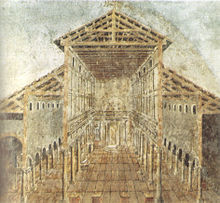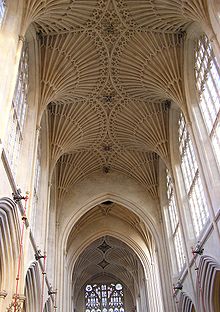Nave

The nave (
Description
The nave extends from the entry—which may have a separate vestibule (the narthex)—to the chancel and may be flanked by lower side-aisles[4] separated from the nave by an arcade. If the aisles are high and of a width comparable to the central nave, the structure is sometimes said to have three naves. It provides the central approach to the high altar.
Etymology
The term nave is from navis, the
History


The earliest churches were built when builders were familiar with the form of the Roman
The nave, the main body of the building, is the section set apart for the laity, while the chancel is reserved for the clergy. In medieval churches the nave was separated from the chancel by the rood screen; these, being elaborately decorated, were notable features in European churches from the 14th to the mid-16th century.[3][1][7]
Medieval naves were divided into bays, the repetition of form giving an effect of great length; and the vertical element of the nave was emphasized. During the Renaissance, in place of dramatic effects there were more balanced proportions.[1]
By the 1300s, the maintenance and decoration of the nave of parish churches was the responsibility of the parishioners; the clergy were responsible for keeping the chancel in repair.[8]
Record-holders
- Longest nave in world: Basílica de la Santa Cruz del Valle de los Caídos, 262 m (860 ft) total; divided via added partition to not exceed that of St. Peter's in Rome[9]
- Longest nave in Denmark: Aarhus Cathedral, 93 m (305 ft)
- Longest nave in England: Winchester Cathedral, 170 m (560 ft)
- Longest nave in Ireland: St Patrick's Cathedral, Dublin, 91 m (299 ft), externally
- Longest nave in France: Bourges Cathedral, 91 m (299 ft), including choir where a crossing would be if there were transepts
- Longest nave in Cologne cathedral, 58 m (190 ft), including two bays between the towers
- Longest nave in St Peter's Basilica in Vatican City, 91 m (299 ft), in four bays
- Longest cathedral nave in Spain: Seville, 60 m (200 ft), in five bays
- Longest nave in the United States: Cathedral of St. John the Divine, New York City, United States (Episcopal), 70 m (230 ft)
- Highest vaulted nave: Beauvais Cathedral, France, 48 m (157 ft), but only one bay of the nave was actually built; however, choir and transepts were completed to the same height.
- Highest completed nave: St. Peter's Basilica, Vatican City, 46 m (151 ft)
See also
- Abbey, with architectural discussion and ground plans
- Cathedral architecture
- Cathedral diagram
- List of highest church naves
References
- ^ a b c d e f g The Editors of Encyclopaedia Britannica. "Nave". Encyclopaedia Britannica (online ed.). Encyclopædia Britannica, Inc.
- ISBN 9780198606789.
- ^ a b c d Cram, Ralph Adams. Nave. The Catholic Encyclopedia. Vol. 10. New York: Robert Appleton Company, 1911. Accessed 13 July 2018
- ^ "Nave". Answers.com. Retrieved 11 February 2015.
- ^ "Ship as a Symbol of the Church (Bark of St. Peter)". JesusWalk.com. Retrieved 11 February 2015.
- Sidney Herald. Sidney, Montana. 10 June 2008. Retrieved 3 January 2016.
- ^ "Rood screen". Encyclopædia Britannica. Retrieved 11 February 2015.
- ^ "Parish Life in Mediaeval England". Masterpieces of Catholic Literature in Summary Form. 2. New York: Harper & Row: 42. January 1965.
- ^ "The Valley of the Fallen". Retrieved 11 November 2019.


